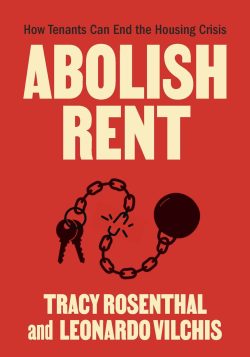Two summers ago I sat among a crescent of tenant union members in the ballroom of a debt-burdened collectively run community center, the Omni Commons, in Oakland. My union, Tenant and Neighborhood Councils (TANC) was hosting the West Coast convening of the Autonomous Tenant Union Network (ATUN). In a dozen or so small groups throughout the hall, unionists shared long term hopes for the movement. In notes, I spun the fibers of our group’s conversation. Then, I raised my hand to offer the thread another person had transcribed on a giant sticky note: “In 20 years, we will have built an international land & tenant movement connected across rural & urban geographies, composed of a mix of growing & increasingly militant tenant unions, communes, & seized productions in some regions, bringing up the next generation with full communism and a habitable earth on the horizon.” We had revived a classic communist theme, the abolition of the separation of town and country. As photographer of that day’s stickies, I was fortunate to retain this original, which now hangs framed by my desk. I find myself looking toward it whenever I need a lodestar. Regardless of its brightness, its direction is still unclear. Each of that sentence’s phrases points somewhere, but where?
Words are more easily spun than social movements. What would it take to connect rural land struggles and urban tenant unions? Communes and seized productions? Whatever all those terms refer…(Only one of them, those of us in that room had shared experiences with). And what would full communism and a habitable earth even look like?
Linked together through these common themes are two recent books, both published on the same day in the September of 2024: Abolish Rent by Tracy Rosenthal and Leonardo Vilchis and The Commune Form by Kristin Ross. The former is addressed to the US tenants movement, while the latter to international rural land defense. By comparing the representations of struggle in these two books —their figures of militancy, analyses of social conditions, and theories of movement practice—we can find some negative space where these movements of country and town might be united.
Ross, Rosenthal, and Vilchis do not themselves illustrate the map for a revolutionary abolition of geographic separation; our hopeful destination appears decades off and providing such a map would be too much to ask for now, since such movements scarcely exists outside aspiration. However, comparing these books allows us to draw a rough sketch of a shared revolutionary project. Abolishing the separation of town and country is another way of saying the abolition of capitalism in which each one—town and country—must be brought into dialectic. The Commune Form and Abolish Rent are exceptional, concise works on the prospects of communism in rural and urban areas., respectively Many of their limitations can be partially tied to the limits of their territories—since only a communism that can span geography will be long for this world. In short, while somewhat unfair, these books must be judged on this land-roving basis—that is, the basis of communism.
The singular feature of cities and towns is that people live in them in great, often growing, numbers. As the proportion of urbanized land grows globally, so too does the proletarian share of the population (whether employed or not). The bulk of commodity production, circulation, and consumption occurs in these areas, increasingly revolving around home life—political economy returning transformed to whence it came: polis to the city, economos to the rule of the home. In the United States, around two thirds of households own their homes, living mostly in and around towns and villages, while the majority of tenants live in cities.1USAFacts, “What Is the Homeownership Rate in the United States?” (July 26, 2024), accessed December 3, 2024, https://usafacts.org/answers/what-is-the-homeownership-rate/country/united-states/; Brian Edward Johnson and Jason Shifferd, “Who Lives Where: A Comprehensive Population Taxonomy of Cities, Suburbs, Exurbs, and Rural Areas in the United States,” Geographical Bulletin 57, no.1, article 3 (2024): https://digitalcommons.kennesaw.edu/cgi/viewcontent.cgi?article=1159&context=thegeographicalbulletin. In Abolish Rent, Rosenthal and Vilchis tell the story of the “resurgent tenant movement” in today’s cites. They do so by following Los Angeles Tenants Union (LATU), a member-funded and -run—that is, autonomous—tenant union, which they (among others) cofounded in 2015 to stop gentrification’s “displacement and replacement of the poor by profit.”2Tracy Rosenthal and Leonardo Vilchis, Abolish Rent: How Tenants Can End the Housing Crisis (Chicago: Haymarket, 2024), 3, 66. Rosenthal and Vilchis polemicize against rent itself, hence the title. They sketch the preceding century’s political economic war against tenants and find signs of revolutionary potential in the rent strikes, occupations, and conviviality of Los Angeles’s organized tenants struggling for collective control over land.
But urbanization occupies only around 3 percent of land globally; the rest is, more or less, countryside.3Zhifeng Liu et al, “How Much of the World’s Land Has Been Urbanized, Really? A Hierarchical Framework for Avoiding Confusion.” Landscape Ecology 29, no. 5 (May 1, 2014): 763¬–71, https://doi.org/10.1007/s10980-014-0034-y. Still, about 40 percent of humanity lives scattered throughout this vast territory, gradually dwindling while increasingly subject to the capitalist demand of the urban majority—to produce something that we can use for profit or get out.4The numbers are somewhat disputed but one estimate showed annual declines and a 43 percent total in 2022. Hannah Ritchie, Veronika Samborska, and Max Roser, “Urbanization,” Our World in Data, accessed December 3, 2024, https://ourworldindata.org/urbanization. Production here usually means agricultural cultivation and resource extraction, except when it means building infrastructure (that is, turning country into town or at least into a corridor from one town to another).
In The Commune Form, Ross tracks a global trajectory of land defenses against such capitalist development projects like police facilities, oil pipelines, monocultural agribusiness, military bases, malls, and (most of all) airports. For Ross, a retired French literature professor, the exemplary campaign was the ZAD de Notre-Dame-des-Landes near Nantes, France (usually called the ZAD in English, a backronym meaning the Zone to Defend). By 2018 the ZAD had prevented clearance of four thousand acres of farms and countryside for an international airport.5Kristin Ross, The Commune Form: The Transformation of Everyday Life (New York: Verso, 2024), 31. These defenses constitute a contemporary variation on what she calls the commune form, based on the experience and imaginary of the 1871 Paris Commune, whose poetics and politics Ross reanimates in earlier books.6Kristin Ross, The Emergence of Social Space: Rimbaud and the Paris Commune (London; New York: Verso, 2008); Kristin Ross, Communal Luxury: The Political Imaginary of the Paris Commune (London; New York: Verso, 2016).
Revolutionary Subjects?
The figure of Ross’s militant in the commune, the “defender of the earth,” comes to the fore under two guises. In the first—in the Sanrizuka struggles of the 1960s and 1970s in Japan’s Kantō Plain against the Narita International Airport, and the 1970s fight for the Larzac plateau in France against a military base expansionism—the defender’s name is a social class: paysan, translating literally from French as peasant. Paysan refers to the small holder rather than agricultural worker producing commodities.7Ross, The Commune Form, 27, 30, 43–45. Residual to older productive modes, the paysan represents a defense of ecologically inclined subsistence living against capitalist redevelopment for profit and dominance; the paysan is conservative as in conservationist (rather than reactionary, contrary to their representation in some strains of Marxism after Marx’s “Eighteenth Brumaire”).8Ross, The Commune Form, 37–40. Elsewhere Ross cites Marx’s late letters to Vera Zasulich which cast a favorable, hopeful light on peasants and rural communes. Ross 65-66; Karl Marx, “Marx-Zasulich Correspondence: Letters and Drafts,” in Theodor Shanin, ed., Late Marx and the Russian Road: Marx and the Peripheries of Capitalism (New York: Monthly Review Press, 1983). They also represent solidarity, according to the example of the Nantes Commune, where paysans during May 1968 supported striking workers by extending their networks of food provision.9Ross, The Commune Form, 13.
The second guise of Ross’s militant, identified in some recent struggles, is that of a “composed,” or a “collective subject formed out of the many.”10Ross, The Commune Form, 100. According to Ross, these struggles are marked by the defender’s shedding of specific class (or other) identities. Those struggles in which paysans, or Indigenous or Black people for that matter, lead decisions, rely more on defense of an imposed identity than what she calls composition (a practice considered essential to this commune form). The author pursues this claim without regard to contravening evidence. At times, Ross implies that groups like the Black Panthers or the Standing Rock Sioux lacked class and cultural diversity within their formations (which is false), while French countryside militants have an “improbable assortment” in theirs (a classic Eurocentric error).11Ross, The Commune Form, 16–17, 97–99. Ross makes additional remarks about the Black Panthers, who she praises as practitioners of the commune form, which indicate gaps in her knowledge about them. Besides their presence in Oakland, she usually associates them with Detroit. While the Panthers had a chapter in Detroit, it was much less known than, say, that of Fred Hampton in Chicago. Joshua Blume and Waldo E. Martin Jr., Black against Empire: The History and Politics of the Black Panther Party (Berkeley: University of California Press, 2013). She also says it’s “best to always call them by their full name” the Black Panther Party for Self-Defense. In fact, the Party dropped “for Self-Defense” from their name in 1968. Blume and Martin Jr., Black Against Empire, 114. That said, in the case of Standing Rock, Ross comes around to acknowledge that the water protectors were able to rally non-native militants because it was “at the heart…an unprecedented alliance made up of over 350 Indigenous nations.”12Ross, The Commune Form, 103.



